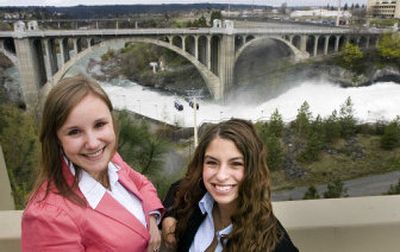Interns bring energy, creativity to dry topic of water conservation

Willy Water has a raindrop for a head, but his shades are cool, and he’s got some attitude. Hey, that used Kleenex belongs in the garbage, not flushed down the toilet, wasting six gallons of fresh water.
Willy Water was created in the 1940s by the American Water Works Association. He was reborn this year because of two young women working as Spokane City Hall interns. Chelsea Wood and Jennifer Davis-Smith were assigned the task of making water conservation both exciting and educational, especially for our young people.
We baby boomers grew up with Litterbug of “Don’t be a Litterbug” fame and with Smokey Bear. You don’t see many people our age chucking empty fast-food containers out car windows. And we build campfires with Smokey’s reminder that only we can prevent forest fires.
Litterbug and Smokey are historical icons to Chelsea, 20, and Jennifer, 21. But they remember a recycle robot, played by Spokane actor Patrick Treadway, who visited their elementary schools, beeping about the importance of recycling. Chelsea and Jennifer hope Willy Water becomes as famous as all these icons.
Last September, the City Council approved a resolution to create and implement a Water Stewardship Program. Chelsea and Jennifer were put in charge of it. The two women feel fortunate they never experienced a CFC internship, short for “coffee, filing and copy.”
Instead, they spent the past year researching water use issues and building the city’s water conservation Web site, www.waterstewardship.org. They also updated Willy Water’s look, with the help of freelance artist Lindsey Davis.
“I was raised in Spokane and my mom is an environmentalist,” said Chelsea, a junior at Gonzaga University. “We never ran the water while brushing our teeth.”
Jennifer, a GU grad, said, “Willy’s message is that it’s cool to save water. It’s fun.”
Jennifer is now headed to Seattle, where she’ll start law school in June. Chelsea will shepherd the project into its public awareness stage. On Bloomsday weekend, in River Park Square, she will build a 300 milk-jug pyramid to demonstrate how much water is used while watering a lawn for just 30 minutes. She’ll introduce Willy Water to the public and unveil his slogan: Our water. Our future. Our priority.
These young women are too polite to say it, but I’m not. We are water hogs in the Inland Northwest. We have been spoiled rotten by the Spokane Valley/Rathdrum Prairie Aquifer. We act as if clean drinking water is our Inland Northwest birthright. So we clean our sidewalks with hoses, and turn on sprinklers in the midday sun.
It will most likely take a crisis, such as aquifer contamination, for most adults to abandon hoggish water ways. But our children can grow up more enlightened. I’m betting that the newest generation will embrace this water-saving bathroom rule: If it’s yellow, let it mellow. If it’s brown, flush it down.
On the Web site, you’ll find coloring books for kids, plus lots of water conservation suggestions for adults. For instance, watering your lawn takes 5 to 10 gallons of water per minute. Washing your car in your driveway consumes 100 gallons of water. So why not wash your car on the lawn?
Some people who move to the Inland Northwest from arid climates are already schooled in water conservation. They have replaced water-guzzling lawns with less thirsty plants.
We in the Inland Northwest are new to the idea. But if water stewardship takes off, and Willy Water becomes an everlasting icon, Chelsea and Jennifer will leave a legacy of fresh water, cherished and preserved. Nice work, women.